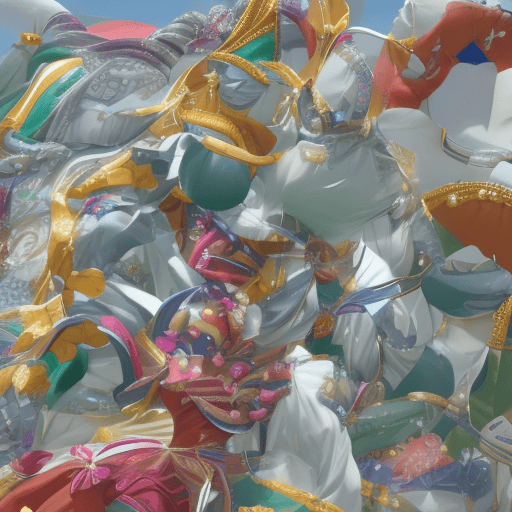Experience the Magic of Carnival Events: From Parades to Parties, We’ve Got You Covered!

1. Introduction
Carnival events are a time-honored tradition celebrated all over the world, bringing people together in a joyous and festive atmosphere. These events, which typically take place before the start of Lent, are marked by parades, parties, and plenty of fun and games. In this article, we’ll explore the magic of carnival events, from the parades to the parties, the costumes, food, music, and decorations. Whether you’re a seasoned carnival goer or a first-timer, this article will provide you with all the information you need to make the most of your carnival experience. So let’s get started!

2. Parades
Parades are one of the most iconic aspects of carnival celebrations. They are a vibrant display of color, music, and joy that captures the essence of the festival. There are many different types of parades that take place during carnival season, each with its own unique characteristics and traditions.
One of the most popular types of parades is the street parade. These parades typically feature floats, marching bands, and performers walking or dancing down the streets of the city. The floats are often intricately designed and decorated, featuring themes and motifs that reflect the culture and history of the region. Marching bands play lively music, while performers dressed in elaborate costumes add to the festive atmosphere.
Another type of parade that is popular during carnival season is the torchlight procession. This type of parade takes place after dark and features participants carrying lit torches or lanterns. The torches create a magical ambiance as they cast flickering shadows on the pavement. Torchlight processions are often held in historic cities or towns, where they serve as a nod to the tradition

3. Costumes
Costumes play a significant role in carnival celebrations, as they allow participants to express themselves and immerse themselves in the spirit of the event. Whether it’s a colorful feathered headdress or a detailed masquerade mask, costumes are an essential part of the carnival experience.
There are many different types of costumes worn during carnival celebrations, ranging from elaborate and intricate designs to more simple and playful looks. Some of the most popular costumes include those inspired by mythical creatures such as mermaids and unicorns, as well as more traditional costumes based on cultural and historical references.
One of the most impressive aspects of carnival costumes is their level of detail and craftsmanship. Many costumes are handmade, with participants spending months creating their perfect look. This attention to detail extends to the accessories, with many costumes featuring intricate jewelry, hats, and shoes.
Carnival costumes are not just about looking good; they are also a way for participants to express themselves and connect with others who share their passion for the event. The sense of community and shared experience is a key part of the carnival tradition, and the costumes are a big part of this.

4. Food and Drinks
Carnival events are not just about the colorful costumes, lively music, and exciting parades; they are also a culinary extravaganza! The food and drinks served during these festivities are just as important as the entertainment itself. In this section, we’ll explore the delicious offerings that carnival events have to offer and provide recipes for some of the most popular dishes and drinks.
One of the most iconic foods associated with carnival celebrations is the king cake. This sweet bread is typically made with a yeast dough and filled with sugar, fruit, and sometimes pecans or cream cheese. The filling is usually in the form of a ring or circle, symbolizing the circular shape of Mardi Gras celebrations. To add to the fun, a small plastic baby is hidden inside the cake, which represents the Baby Jesus. Whoever finds the baby in their slice gets to host the next party.
Another popular food item at carnival events is gumbo. This hearty soup is made with a combination of seafood, meat, and vegetables, and is often served with rice. Gumbo is a staple in many Southern carnival celebrations and is believed to have originated from West African dishes brought to the United States by enslaved people.
For those looking for something a little sweeter, beignets are a must-try. These deep-fried dough balls are coated in powdered sugar and can be found at many carnival events. They are originally from France but have become a beloved treat at Mardi Gras celebrations in New Orleans.
Of course, no carnival event would be complete without the classic cocktail, the Hurricane. This potent drink was invented in New Orleans and is made with dark rum, passion fruit juice, lemon juice, and grenadine. It’s the perfect way to cool off while enjoying all the festivities.
So whether you’re a foodie or just enjoy good eats, carnival events have plenty of delicious options to satisfy your taste buds. Don’t forget to try some of these tasty treats and create your own memories during your next carnival celebration.

5. Music and Dancing
Carnival events are known for their lively and energetic atmosphere, and music and dancing play a significant role in creating this atmosphere. The music and dance styles associated with carnival celebrations vary depending on the region and country, but they often include a mix of traditional and modern sounds.
One of the most popular music genres associated with carnival celebrations is soca, which originated in Trinidad and Tobago and is characterized by its upbeat tempo and catchy chants. Soca music is often played during parade floats and is a favorite among revelers who enjoy dancing to its infectious rhythms.
Another popular genre of music at carnival events is calypso, which is also originated from Trinidad and Tobago. Calypso is characterized by its storytelling lyrics and Afro-Caribbean rhythms. It is usually performed by solo artists or groups, and the lyrics often comment on current events and social issues.
In addition to soca and calypso, other music genres such as reggae, zouk, and hip hop are also commonly featured at carnival events. These genres bring a diverse range of sounds and styles to the celebrations, making them even more exciting and entertaining.
When it comes to dancing, carnival events offer a wide variety of styles and moves. One of the most popular dances is the J’ouvert parade, which takes place in Trinidad and Tobago and features revellers dressed in colorful costumes dancing to soca music. Another popular dance is the Samba, which originated in Brazil and is characterized by its sensual movements and energetic beat.
Other dance styles that can be seen at carnival events include the Cha-Cha, Merengue, and Cumbia. Each style has its own unique steps and rhythms, and dancers often show off their skills in these styles during carnival parades and parties.
Overall, music and dancing play a crucial role in carnival celebrations, providing a soundtrack for the festivities and offering a platform for people to express themselves through movement and rhythm. Whether you’re a fan of soca, calypso, or any other genre of music, or prefer to watch others dance, carnival events are the perfect opportunity to let loose, have fun, and experience the magic of music and dance.

6. Theme and Decorations
Carnival events are known for their vibrant colors, lively music, and energetic crowds. But one of the most important aspects of these festivities is the theme and decorations. Every year, organizers carefully select a theme or concept to guide the design and execution of the event. This can range from a specific color scheme to a more complex narrative or storyline. The theme and decorations set the tone for the entire carnival experience, creating a sense of wonder and excitement for attendees.
In addition to the main parade, there are often smaller parades and street parties throughout the city that follow the same theme. These smaller events provide an opportunity for locals and visitors alike to join in the fun and show off their creativity and ingenuity. From floats and costumes to street signs and buildings, everything is designed to fit the chosen theme.
One of the most iconic examples of a well-executed theme is the annual “Carnaval de Rio de Janeiro” in Brazil. Each year, the theme is based on a different aspect of Brazilian culture, such as the country’s rich history, its diverse wildlife, or its vibrant music scene. The streets are transformed into a colorful extravaganza, with floats, costumes, and decorations all perfectly aligned with the chosen theme.
Another great example is the “Carnaval de Nice” in France. The theme for this event is always related to the sea and the coastal region. The floats and costumes are designed to resemble fish, boats, and other nautical objects. The streets are filled with sand and seashells, and even the city’s landmarks are decorated to match the theme.
The theme and decorations of a carnival event are not just aesthetic pleasures; they play an essential role in creating a unique and unforgettable experience for attendees. Whether it’s a grand parade or a small street party, every element of the carnival is designed to capture the imagination and transport participants to another world. So if you’re ever lucky enough to attend a carnival event, be sure to keep an eye out for the theme and decorations – they’re the secret ingredient that makes these festivities so magical.

7. History and Origins
Carnival celebrations have a rich and fascinating history that dates back centuries. These festivities were originally held in pre-Lenten seasons as a way to mark the end of winter and celebrate the arrival of spring. The word “carnival” comes from the Latin word “carnelevare,” which means “to remove meat,” symbolizing the removal of meat from the diet during Lent. Over time, carnival traditions evolved and spread throughout Europe and eventually to other parts of the world. Today, carnival events can be found in countries such as Brazil, Venice, and New Orleans, each with its unique traditions and celebrations. In many places, carnival is seen as a time for people to let loose, dress up, and enjoy the moment before the solemnity of Lent begins.

8. Safety Tips
Safety should always be a top priority when attending any event, especially one as lively and exciting as a carnival. Here are some tips to keep you safe during parades and parties:
1. Stay hydrated: With all the excitement and activity, it’s easy to forget to drink water. Make sure to bring a refillable water bottle and drink plenty of fluids throughout the day.
2. Wear comfortable shoes: Parades can last for hours, and standing for long periods of time can be tiring. Make sure to wear comfortable shoes that provide good support to avoid blisters or other foot injuries.
3. Dress appropriately: Depending on the theme of the carnival, dressing inappropriately could lead to unwanted attention or even harassment. Choose a costume that is appropriate for the occasion and respects the culture and traditions of the event.
4. Be aware of your surroundings: When walking through crowded streets or participating in activities, be aware of your surroundings and watch out for potential hazards such as uneven pavement or flying debris.
5. Use sunscreen: If the carnival takes place outdoors, be sure to apply sunscreen to protect yourself from the sun’s harmful UV rays.
6. Don’t overindulge: While carnival events often involve indulging in delicious food and drinks, it’s important to remember to eat and drink responsibly. Don’t drink and drive, and pace yourself so you don’t end up feeling sick.
7. Follow the rules: Each carnival event may have its own set of rules and regulations. Make sure to read and follow these rules to ensure your safety and the safety of others.
By following these simple safety tips, you can enjoy all the fun and excitement of a carnival event without worrying about your safety. Happy carnival celebrations!

9. Conclusion
In conclusion, carnivals are a time-honored tradition that bring people together to celebrate life, culture, and community spirit. From parades to parties, costumes, food, music, dancing, and decorations, there is something for everyone to enjoy. Whether you’re a first-time carnival attendee or a seasoned veteran, we hope this article has provided you with valuable insights into the magic of carnival events. Remember to stay safe and have fun!



0 Comments